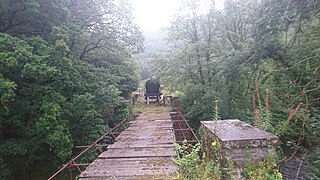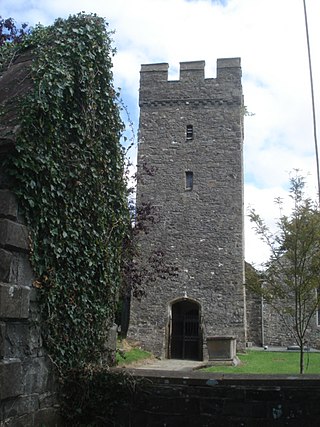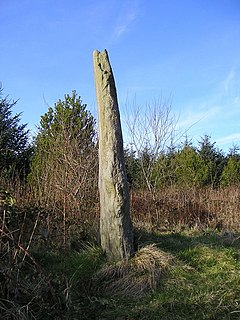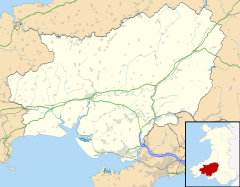
Abergwili is a village and community in Carmarthenshire, Wales, near the confluence of the rivers Towy and Gwili, close to the town of Carmarthen. It is also an electoral ward. Named after the village of Abergwili, the community includes the settlements of Peniel, Llanfihangel-uwch-Gwili and White Mill. The grounds of the former Bishop's Palace are listed on the Cadw/ICOMOS Register of Parks and Gardens of Special Historic Interest in Wales.

The Gwili Railway is a Welsh heritage railway, that operates a preserved standard gauge railway line from the site of Abergwili Junction in southwest Wales along a four-and-a-half-mile (7.2 km) section of the former Carmarthen to Aberystwyth line. The original railway closed in 1965, with the track being lifted in 1975.

Carmarthen railway station is on is on the West Wales Line serving the town of Carmarthen, Wales, south of the River Towy. The station is operated by Transport for Wales. Great Western Railway also run a limited service between Carmarthen and London Paddington, usually six trains each way daily with an additional return service to Bristol Parkway.
Llanfihangel-ar-Arth is a village and community in the county of Carmarthenshire, Wales.

The Carmarthen–Aberystwyth line was originally a standard-gauge branch line of the Great Western Railway (GWR) in Wales, connecting Carmarthen and Aberystwyth.

Carmarthen West and South Pembrokeshire is a constituency of the Senedd. It elects one Member of the Senedd by the first past the post method of election. In addition, it is one of eight constituencies in the Mid and West Wales electoral region, which elects four additional members, in addition to eight constituency members, to produce a degree of proportional representation for the region as a whole.

Bronwydd is a village and community in the county of Carmarthenshire, Wales, situated about three miles north of Carmarthen in the valley of the River Gwili. Bronwydd community comprises the village of Bronwydd Arms, a couple of nearby hamlets and a number of working farms in the surrounding area. In Census 2011, it had a population of 564.

Cilycwm is a village, parish and community located in Carmarthenshire, Wales. The community population taken at the 2011 census was 487.

Cynwyl Elfed is a village and community in the county of Carmarthenshire, Wales. The community includes the villages of Cynwyl Elfed, Blaenycoed and Cwmduad. It is situated about 5 miles (8.0 km) north of Carmarthen and had a population of 953 in 2001, increasing to 1,044 at the 2011 Census.

Llangeler is a hamlet and community located in north Carmarthenshire, Wales. The name is believed to refer to St. Gelert. Llangeler parish covers a wide area including to the west, the textile village of Drefach Felindre, Waungilwen, Cwmpengraig and to the east, Pont Tyweli which adjoins Llandysul on the Carmarthenshire side of the River Teifi. The population of the parish was 3,222 at the Census of 2001, increasing to 3,427 at the 2011 census.
Llanllawddog is a community located in Carmarthenshire, south-west Wales. The population of the community taken at the 2011 census was 703.
Newchurch and Merthyr is a community located in Carmarthenshire, Wales including the villages of Newchurch and Merthyr. The community population at the 2011 census was 676.
Llan and its variants are a common element of Celtic placenames in the British Isles and Brittany, especially of Welsh toponymy. In Welsh the name of a local saint or a geomorphological description follows the Llan morpheme to form a single word: for example Llanfair is the parish or settlement around the church of St. Mair. Goidelic toponyms end in -lann.
Ceitho was an abbot and a saint living in West Wales in the 6th century. According to legend he was one of the five sons born to Cynyr Barbtruc of Cynwyl Gaeo, and a descendant of the ancient Welsh king Cunedda Wledig. Along with his brothers Gwynno, Gwynoro, Celynin, and Gwyn, he became a saint. The five brothers are said to have founded the village Llanpumsaint.
Martha Llwyd, born Martha Williams, was a Welsh poet and Methodist hymnwriter. Due to health problems, Llwyd was unable to walk. She was carried aloft in her chair.

The River Gwili in Carmarthenshire, is a tributary of the River Towy, the longest river entirely in Wales. Its headwater is found east of Llanllawddog, in the Brechfa Forest. It runs west, through Llanpumsaint, to its confluence with the River Duad, just south of Cynwyl Elfed village. Here its course turns to the southeast, running through Bronwydd before joining the River Towy at Abergwili.
Llanpumpsaint was a railway station near the village of Llanpumpsaint, West Wales, serving the hamlet and the rural locale.

Conwil was a railway station near the village of Cynwyl Elfed in Carmarthenshire, Wales, serving the hamlet and the rural locale. It was once a thriving railway station, transporting both passenger traffic and locally produced goods, including wool, livestock, milk and timber.
The first election to the Carmarthen Rural District Council in Carmarthenshire, Wales was held in December 1894. It was followed by the 1898 election. The successful candidates were also elected to the Carmarthen Board of Guardians. In rural parishes, many councillors were returned unopposed.

![]() Welsh pronunciation ; Welsh "Llan" church + "pum" five + "saint" saint(s)) is a village and community in Carmarthenshire, Wales. In the 2001 UK Census, Llanpumsaint community had a population of 595. [1] It is not to be confused with Pumsaint, a small village some distance away on the River Cothi. The population increased in 2011 to 734, and thus the percentage of Welsh speakers declined. [2]
Welsh pronunciation ; Welsh "Llan" church + "pum" five + "saint" saint(s)) is a village and community in Carmarthenshire, Wales. In the 2001 UK Census, Llanpumsaint community had a population of 595. [1] It is not to be confused with Pumsaint, a small village some distance away on the River Cothi. The population increased in 2011 to 734, and thus the percentage of Welsh speakers declined. [2] 










